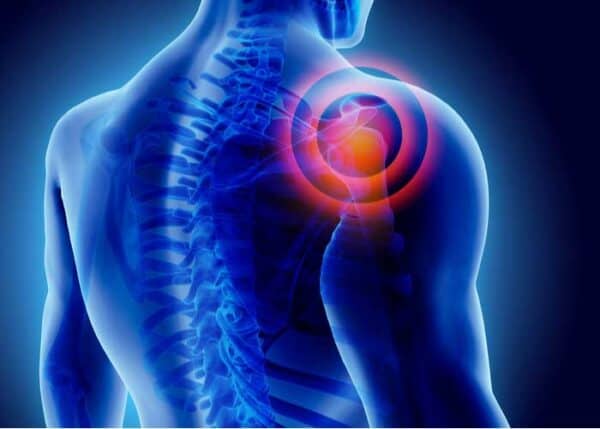Failed Shoulder Stabilization Specialist

A failed shoulder stabilization occurs when a previous surgical procedure does not have a desired outcome. Failed shoulder stabilizations are most commonly caused by additional trauma or new shoulder subluxations or dislocations. Shoulder stabilization specialist, Dr. Matthew Provencher provides diagnosis and both surgical and nonsurgical treatment options for patients in Vail who are experiencing symptoms of failed shoulder stabilization and bone loss within the shoulder. Contact Dr. Provencher’s team today!
What is failed shoulder stabilization?
A failed shoulder stabilization occurs when a previous surgical procedure does not have a desired outcome. Symptoms of a failed shoulder stabilization include:
- Continued or recurrent shoulder dislocations and/or subluxations
- Shoulder pain
- Shoulder instability
- Limited range of motion – stiffness
- Not trusting the shoulder
What causes a shoulder stabilization procedure to fail?
A shoulder stabilization procedure can fail for several different reasons, but the main cause occurs when there is too much laxity or movement within the shoulder capsule. This can lead to recurrent instability, either due to reinjury, re-tear, or compromise of the stabilizing structures around the shoulder joint. Other causes of failed shoulder stabilization include:
- Bone defects in the glenoid socket
- Bone defects in the humerus
- Subsequent bone loss
- Significant labral tears that were not properly repaired
- Poor quality tissue
- New trauma or injury to the shoulder
- Poor patient compliance with rehabilitation
- Repetitive stress to the shoulder after initial stabilization
- Pre-disposing genetic factors such as hypermobility / EDS

How does bone loss affect shoulder stabilization?
Bone defects, specifically bone loss within the glenoid (socket) or humeral head (ball of the shoulder) affects the surface area of the joint and can reduce or compromise stability. Bone loss can make it difficult for the humeral head to stay in place within the socket, increasing the risk of recurrent dislocations after surgery. Bone loss should be addressed in the initial surgery to prevent failed stabilization. However, with subsequent injuries or additional subluxation or dislocations, there can be new damage to the glenoid and humerus.
How is bone loss after stabilization surgery diagnosed?
The best way to diagnose bone loss in the shoulder is with imaging tests. An x-ray shows the basic bone structure of the shoulder, while a CT scan with 3D reconstruction offer detailed assessments of bone defects. An MRI may also be used to evaluate soft tissue damage alongside bone issues. Dr. Provencher will assess the images the patient currently has and will order any new, additional testing.
How do I know if my shoulder stabilization failed?
The common signs of a failed shoulder stabilization surgery are:
- Persistent pain or discomfort
- Recurring shoulder subluxations or dislocations
- Feeling that the shoulder is moving out of place, slipping, or feels unstable.
- Shoulder weakness
- Limited range of motion
- Difficulty performing overhead motions
- Difficulty doing every-day tasks or activities
What is the treatment for failed shoulder stabilization?
Careful evaluation of the diagnostic testing, along with an clinical examination of the shoulder will give Dr. Provencher a good understanding of what type of procedure will be needed. He may suggest one of the following treatment options:
- Revision Surgery: A shoulder procedure using surgical techniques like Latarjet or capsular reconstruction.
- Bone Graft: Adding bone to replace bone loss and restore bone integrity and joint stability.
- Arthroplasty: Used in extreme cases of shoulder instability where the bone is no longer viable. Total or partial shoulder replacement may be necessary.
- Physical Therapy: Used in mild cases of instability to strengthen surrounding muscles that work as dynamic shoulder stabilizers
How long is the recovery after revision shoulder surgery to correct failed stabilization?
The recovery after revision surgery for failed shoulder stabilization can vary by patient, based on the procedure used to correct the problem, patient’s general health and any underlying conditions. In general, patients can expect recovery to take 3-6 months. Physical therapy starts within a few weeks to regain motion, and strengthening exercises are added as healing progresses. Full recovery, including return to sports or high-impact activities, may take up to a year.
Shoulder Stabilization FAQ
Will revision shoulder surgery fix my shoulder stabilization problems caused by bone loss?
Yes, Revision surgery can address both bone loss and restore shoulder stability. Procedures like Latarjet transfers a portion of the coracoid process to the glenoid which gives the shoulder more bone and surface area. Bone grafting techniques, such as a distal tibia allograft, are designed to correct bone defects and correct shoulder instability caused by bone loss.
What is a bone graft, and when is it needed to restore shoulder stability?
A bone graft involves transplanting bone tissue or from a donor bank (allograft) to rebuild areas of bone loss. In shoulder stabilization revision, grafts are used when significant bone defects in the glenoid or humeral head compromise the joint’s stability.
How successful are revision surgeries for failed shoulder stabilization procedures?
The success rate for revision shoulder surgery is high, particularly when done by a skilled, experience surgeon like Dr. Provencher. He uses advanced surgical techniques, proven to repair shoulder stabilization. Patient outcomes often depend on factors such as the extent of bone loss, patient compliance and overall health; however procedures like the Latarjet have an 85% to 90% success rate.
What are the risks of leaving bone loss untreated after a failed shoulder stabilization procedure?
Untreated bone loss can lead to chronic shoulder instability which increases the risk of further shoulder subluxations/ dislocations that can ultimately, cause more bone loss. Cartilage damage and early onset of arthritis can also occur. Untreated bone loss will, overtime, can cause shoulder dysfunction, issues with ADLs (activities of daily living), recurrent and more frequent shoulder instability episodes, and cause post-traumatic arthritic changes.
How do I choose the right surgeon for shoulder revision surgery?
Shoulder revision surgery can be complicated and you need to find a qualified surgeon who has experience and exceptional outcomes. Look for a board-certified orthopedic surgeon specializing in complex shoulder instability surgeries. It is beneficial if they were a part of any shoulder instability research / literature as well. Consider their experience with revision procedures, patient reviews, and success rates. Dr. Provencher is available for expert second opinions and consultations regarding shoulder surgery and especially revision shoulder surgery for failed shoulder stabilization.
How can I prevent shoulder stabilization failure after surgery?
It’s important to follow your surgeon’s post-operative care plan, including physical therapy and activity restrictions. It takes time for bones and tendons to heal, so you need to be patient with the process. It is essential to strengthen to equal, symmetrical upper extremity strengthen that should be assessed with objective measures. Avoid high-impact sports until cleared.
Is there a reason my shoulder stabilization failed?
Failed shoulder stabilization surgery can occur due to a variety of reasons, including:
- Recurrent trauma to the shoulder
- Pre-existing bone defects in the glenoid socket
- Inadequate soft tissue repair
- Bone loss of the glenoid or humerus
- Improper rehabilitation
- Re-injury after surgery, especially for high-impact athletes
- Progressive bone or capsule labrum injury
Can I live with shoulder instability after numerous recurrences or additional injury?
It’s not a good idea. Chronic shoulder instability can worsen if not addressed. Eventually the shoulder stability will worsen to the point of subluxation when doing simple daily activities. Pain from shoulder instability will increase and the shoulder can suffer long-term damage that may not be repairable. In fact, as the shoulder has more subluxation or dislocation events, there is additional damage to the labrum (more extensive labral tears), the glenoid, and the humerus (more bone loss injury) and cartilage injuries. It is a good idea to talk to Dr. Provencher about re-stabilization after additional injury.
What is the best treatment option so my shoulder does not subluxate or dislocate again?
The treatment option that is best to assure no further shoulder dislocations depends on the underlying problem. Bone loss will require a coracoid transfer or Latarjet. Bone grafting for glenoid bone loss may be needed if the bone loss is greater than 10-20%. A simple soft-tissue repair may be all that is required to prevent further subluxations. It is important to follow the recommended physical therapy protocol after surgery to regain strength and aid in the prevention of further shoulder dislocations.
Why does a shoulder stabilization procedure fail?
If you are an athlete, the most common reason for shoulder stabilization failure is due to repeated injury. Other reasons shoulder stabilization may fail include bone loss, humeral head defects, and underlying anatomic issues such as a torn labrum.
Why did my shoulder stabilization fail?
A significant portion of patients may experience recurrent instability after a shoulder stabilization procedure. Studies show that shoulder stabilization surgeries can fail in between 5-30% of the time. The failure rate depends on factors that include the patient’s activity level, the severity of the instability, and the surgical technique used.
Will I get arthritis in my shoulder if it dislocates often?
Yes. Frequent shoulder dislocations will significantly increase the risk of developing arthritis in the joint. Repeated dislocations damage the articular cartilage within the joint which will lead to osteoarthritis.
Do I have arthritis in my shoulder?
If you have pain and stiffness within the shoulder joint you might have arthritis. Other arthritis symptoms in the shoulder include:
- Pain in the front, side or back of the shoulder
- Persistent pain that does not decrease with inactivity
- Crunching, popping or grating sounds when moving the shoulder (crepitus)
- Swelling, warmth or redness in the shoulder
- Stiffness in the shoulder, especially after sleeping or sitting for a long period of time
- Difficulty sleeping
How do I know if I have arthritis in my shoulder?
Dr. Provencher can diagnose shoulder arthritis with a physical exam, medical history, and imaging tests. Imaging tests can include X-rays, ultrasounds, or MRI scans.
What other structures can be injured in a shoulder dislocation?
Shoulder structures that can be injured in a shoulder dislocation include the shoulder labrum, the glenoid (shoulder socket) humerus, ligaments and tendons. Severe dislocations can affect the nerves, muscles, tendons and other structures around the shoulder.
What happens to the hardware that was in my shoulder?
In most cases, the hardware used in shoulder surgeries, like screws or plates are designed to stay in the body permanently. Dr. Provencher may remove old hardware that is no longer useful, broken, or if it hinders the re-stabilization. New hardware may be used to better secure the shoulder. Some types of anchors used in repairs are made from biodegradable materials that the body will naturally absorb over time.